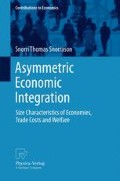Abstract
This chapter applies econometric methods to cross section data to capture the inter-temporal changes in trade flows due to the impact of PTAs with considerations to the size classification established in Chap. 3. Section 5.1 displays the econometric specification of the cross-sectional gravity model and discusses its characteristics. In Sect. 5.2 trade flow effects are investigated, by estimating the effects of selected PTAs on imports and exports of the E45 region for the years 1990, 1995, 2000 and 2005. Section 5.3 undertakes a cross-sectional analysis according to the size classifications established in Chap. 3. Sections 5.5 and 5.6 estimate the trade effects of the EU and CISFTA, with applications to size of countries. Section 5.7 presents a summary and conclusions.
Access this chapter
Tax calculation will be finalised at checkout
Purchases are for personal use only
Notes
- 1.
There are two ways of performing this test. The one used here is suggested by Koenker (1981) in which the test is performed by running an auxiliary regression of the logarithms of the original equation‘s squared residuals. R-squared is calculated from this auxiliary regression and the statistics sample size (n) times R-squared is computed, which has an asymptotic Chi-squared distribution with p degrees of freedom under the null hypothesis of homoskedasticity, where p is the number of estimators in the auxiliary regression.
- 2.
White showed that a valid estimator of \( Var\left( {{{\hat{\beta }}_i}} \right) \)for heteroskedasticity of any form (including homoskedasticity) is:
$$ \frac{{\sum\limits_{{i = 1}}^n {{{({x_i} - \bar{x})}^2}\hat{u}_i^2} }}{{SST_x^2}} $$When this equation is multiplied by the sample size\( n \), it converges in probability to: \( E\left[ {{{({x_i} - {\mu_x})}^2}u_i^2} \right]/{(\sigma_x^2)^2} \).
The law of large numbers and the central limit theorem play key roles in establishing these convergences. This leads to the statement that, in large sample sizes, there is a case for always reporting only the heteroskedasticity-robust standard errors in cross-sectional applications.
- 3.
From EUR 3.9 bn in 2000 to EUR −5.9 bn in 2005; EU.
References
Aitken, N. D. (1973). The effects of the EEC and EFTA on European trade: A temporal cross-section analysis. American Economic Review, 63(5), 881–892.
Baldwin, R. E. (1994). Towards an integrated Europe. London: Centre for Economic Policy Research.
Breusch, T., & Pagan, A. (1979). A simple test for heteroscedasticity and random coefficient variation. Econometrica, 47, 1287–1294.
Frankel, J. A. (1997). Regional trading blocs in the world economic system. Washington, DC: Institute for International Economics.
Godfrey, L. G. (1978). Testing against general autoregressive and moving average error models when the regressors include lagged dependent variables. Econometrica, 46, 1293–1302.
Hamilton, C. B., & Winters, A. L. (1992). Opening up international trade with Eastern Europe. Economic Policy, 14, 77–116.
Koenker, R. (1981). A note on studentizing a test for heteroscedasticity. Journal of Econometrics, 17, 107–112.
Martinez-Zarzoso, I. (2003). Gravity model: An application to trade between regional blocs. American Economic Review, 31(2), 174–187.
Nilsson, L. (2000). Trade integration and the EU economic membership criteria. European Journal of Political Economy, 16, 807–827.
Soloaga, I., & Winters, L. A. (2001). Regionalism in the nineties: What effect on trade? The North American Journal of Economics & Finance, 12, 1–29.
White, H. (1980). A heteroskedasticity-consistent covariance matrix estimator and a direct test for heteroskedasticity. Econometrica, 48(4), 817–838.
Author information
Authors and Affiliations
Rights and permissions
Copyright information
© 2012 Springer-Verlag Berlin Heidelberg
About this chapter
Cite this chapter
Snorrason, S.T. (2012). A Cross-Section Analysis of Size Classification and the Effects of Preferential Trade Agreements. In: Asymmetric Economic Integration. Contributions to Economics. Physica, Heidelberg. https://doi.org/10.1007/978-3-7908-2861-0_5
Download citation
DOI: https://doi.org/10.1007/978-3-7908-2861-0_5
Published:
Publisher Name: Physica, Heidelberg
Print ISBN: 978-3-7908-2860-3
Online ISBN: 978-3-7908-2861-0
eBook Packages: Business and EconomicsEconomics and Finance (R0)

